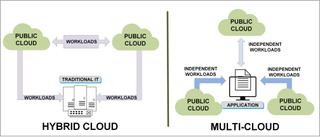Hybrid and Multi-Cloud Practicality
Each differ in the kinds of cloud infrastructure they include

Under the cloud umbrella are the familiar variations—public, private and hybrid clouds. The latter, hybrid, is an environment featuring a combination of both public cloud (e.g., AWS, Azure, Google, others) and private cloud.
By “private cloud,” we mean a “physical location” such as an on-prem data center, a “co-lo” type center, or a managed service dealing directly with users on a contractual basis. Many variations in private clouds exist. Facebook, for example, created its own private cloud for its infrastructure and does not utilize a public cloud to store its data. When scale, security or functional need dictate something outside the boundaries of a public, commercial cloud, users may turn to this privately controlled model.
With those basics defined, an emerging user trend is now developing. Certain specialties now command specifics that demand sets of capabilities that span more than a single service whether public or private cloud. While such a model might be classified as a hybrid cloud environment, there are places and applications where that traditional hybrid cloud implementation expands outside those classic dimensions.
Hybrid Prevails
To place this into perspective—almost no one, today, relies exclusively on the public cloud for computing. Today, a hybrid cloud is categorized as a solution or environment in which applications are running in a combination of differing environments. Reasons include capabilities that cannot be supported exclusively in any public cloud—for example, the production of an entertainment program that demands services at a venue that can’t be done in a virtual cloud platform (live sports clearly needs cameras, sound and human interaction).
Hybrid models are here for the near term, yielding new opportunities to assemble other elements of the production using tools that heretofore were relegated mostly to large frame, custom hardware. Such development is going full speed, but it’s not clear when this will become mainstream. Thus, there are cloud service providers who are focusing on supporting such migrations using specialized capabilities (their own “secret sauce”) that set them apart from their competition.
More than One Cloud
Enter a relatively newer approach to methodologies that promote multiple methods to reach the users’ goals. This relatively recent trend is referred to as “multi-cloud,” (Fig. 1)

Multi-cloud and hybrid cloud models refer to cloud deployments that integrate more than one cloud. Each differ in the kinds of cloud infrastructure they include (Fig. 2). For example, a hybrid cloud infrastructure blends two or more different types of clouds, while multi-cloud blends different clouds of similar type.

Multi-cloud, according to IBM, is “the use of cloud services from two or more vendors,” inferring two or more different public cloud vendors, yet that doesn’t necessarily mean only “public cloud” providers. The multi-cloud approach gives organizations increased flexibility to optimize performance, control costs, and in turn, leverage the “best of breed” cloud technologies available.
Services Today
To set the framework, we need to examine where the technologies lie today. The three better-recognized “cloud services” include Infrastructure as a Service (IaaS), Platform as a Service (PaaS), and Software as a Service (SaaS). Each of these three services utilize some degree of “cloud computing,” usually contained within that cloud under specialties and services that the specific provider has optimized for their particular cloud infrastructure.
Each of the three services’ platforms employ what we refer to as “cloud computing.” By fundamental definition, cloud computing are those technologies that “make the cloud work.” More expanded descriptions include “a remote data center, which contains the (computing) resources that support those applications” and include physical (and virtual) servers, development tools and networking. Each of these services are provided in a cloud-like environment, i.e., “native cloud.”
Some definitions will include “via the internet” and others will describe cloud computing using a “network of remote servers” that are “hosted on the internet” for functionality, which includes “the management, processing and storing of data.” These remote data centers may be managed by a third-party cloud service provider (CSP) who then charges as a subscription-based service with on-demand billing. To the end user/subscriber, they are likely unaware of which services are provided on which cloud model, i.e., private or public.
Compute Offerings
Leading cloud providers, as well as cloud-solution providers (e.g., VMware), may participate in multi-cloud solutions for compute. Wrapped in the cloud compute structure is “infrastructure, development, data warehousing, cloud storage, disaster recovery/business continuity” and more.
Cross cloud utilization is where this multi-cloud “best of breed” concept plays best. For example, artificial intelligence and machine learning may best be practiced in a cloud service environment specially tailored for these operations, given that the scale of servers and storage necessary for a large AI/ML deployment can be intensive. In this example model, deploying a multi-cloud model might involve data acquisition from one cloud provider and compute analytics that might best be served in another.
Benefits gained in this strategy may be realized in different ways by various organizations. Live event or studio production might best be served by vendor A while post production (transcoding, formatting, versioning) might be better served by vendor B. Allowing the user to choose cloud services from varying providers based on performance, function, costs, etc., is now a marketplace-driven agenda compared to past models where you went to a single provider for all those services wrapped into a package—and where you might find certain service capability limitations.
Risk, Vulnerability & Loss
Other important rationale for the multi-cloud model include risk reduction, reduced vulnerability to losses in data, compromise, unplanned downtime or outages, and more. Additional operation strategies that can leverage multi-cloud include licensing, security, service-compatibility and alleviation of signing up with a single provider who can’t offer all the services under one umbrella.
Unfortunately, as all these cloud models grow, user/administrators have been facing what is referred to as “shadow-IT,” i.e., “you can’t protect what you can’t see.” The explosion of unsanctioned applications, software and devices is weighing heavily on the CIOs who must develop policies based upon the knowns. By limiting the services to a single solution, you could risk pushing the limits, which you can’t see, touch or know about until you arrive there and find “you just can’t do that here.”
Multi-cloud uses are still evolving. Full feature sets will require additional support and conduits to or from the variations. Inside the media and entertainment technology domains, efforts to establish best current practices for elements like multi-cloud—which requires ground-to-cloud and cloud-to-ground (GCCG) parameters—are moving forward. Harmonization of how well one cloud provider’s services (e.g., software-defined networking for compressed signal production) versus another’s capabilities (e.g., in compilation and distribution) will allow users to experience opportunities in cloud-to-cloud services that can more easily react to the needs of the entire ecosystem.
Get the TV Tech Newsletter
The professional video industry's #1 source for news, trends and product and tech information. Sign up below.
Karl Paulsen is the CTO for Diversified, the global leader in media-related technologies, innovations and systems integration. Karl provides subject matter expertise and innovative visionary futures related to advanced networking and IP-technologies, workflow design and assessment, media asset management, and storage technologies. Karl is a SMPTE Life Fellow, a SBE Life Member & Certified Professional Broadcast Engineer, and the author of hundreds of articles focused on industry advances in cloud, storage, workflow, and media technologies. For over 25-years he has continually featured topics in TV Tech magazine—penning the magazine’s Storage and Media Technologies and its Cloudspotter’s Journal columns.

